This was published 3 years ago
Off limits for 35 years, rooms above Flinders Street station burst to life
By Kylie Northover
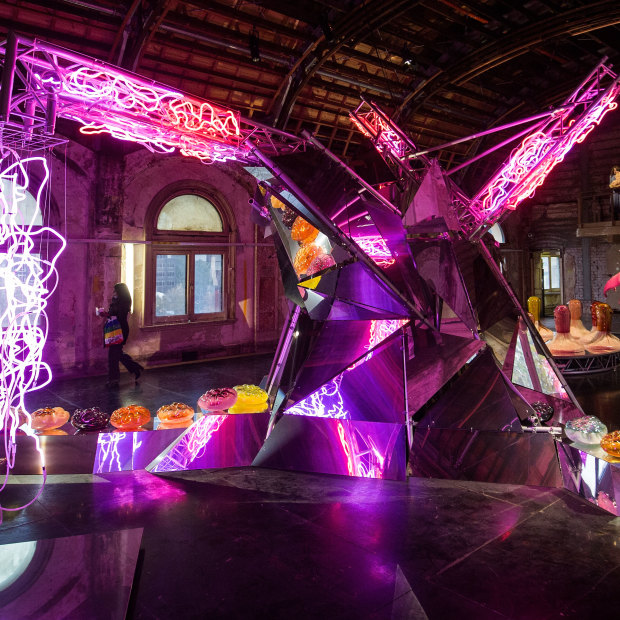
A view of the transformed ballroom above Flinders Street station.Credit: Getty
Like most Melburnians, artist Patricia Piccinini has always known about the fabled spaces above Flinders Street Station, the warren of rooms that sit high above the platforms, and the famous ballroom.
“But I had no dream of ever being able to access it,” she says.
For the past two years, she and her team have reimagined the station’s long-closed spaces to create A Miracle Constantly Repeating, her biggest Melbourne show in almost 20 years, for the inaugural RISING festival.
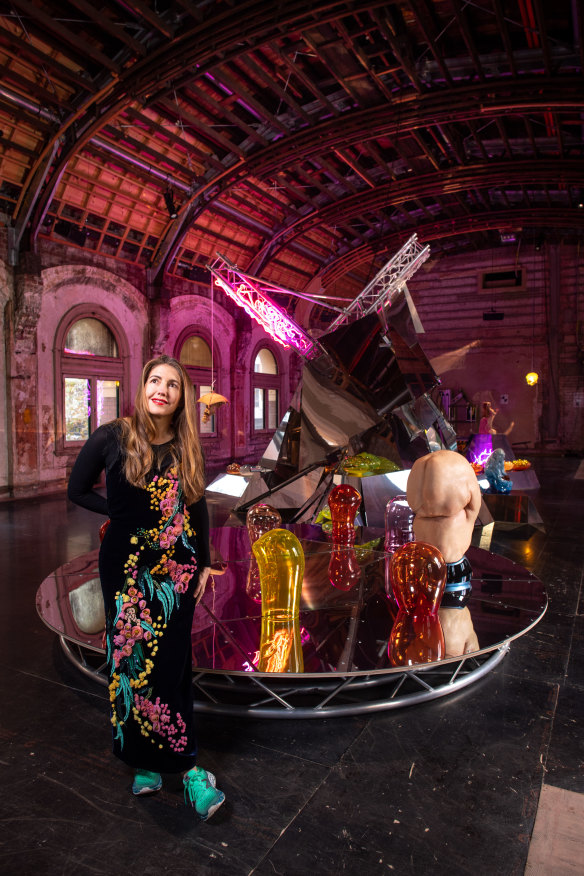
Patricia Piccinini with some of her new works in the Flinders Street ballroom.Credit: Eddie Jim
Festival directors Hannah Fox and Gideon Obarzanek were determined to use the city’s spaces in unexpected ways and the mix of Piccinini’s hyper-real transgenic sculptures, which suggest a disquieting parallel universe or a glimpse into a potential future, is inspired; the station’s hidden-in-plain sight mystery and faded grandeur offer a delicious backdrop.
For the sprawling exhibition, the station’s mysterious rooms have been transformed into an other-worldy ecosystem.
Mounting a show of this scale is challenging, but here, the process has been monumental; when Spectrum is granted a walk-through before the installation, there are builders, producers, OHS and COVID regulations being put in place. Added to that is the fact that everything must fit through a door only 84cm wide and that the entire building, down to the peeling paint and the rust on the pressed-metal ceilings, is heritage-listed.
Piccininiwas thrilled when Fox and Obarzanek approached her, but concedes she initially found the scale of the spaces intimidating. “But I knew I could inhabit this place in a really interesting way,” she says. “And because the ballroom is so grand, it’s given me an opportunity to do something quite different.”
Her works – which for this show include sculptures, film, light works and, for the first time, blown glass pieces – colonise 11 rooms, all of which have different themes.
“One thing we can’t do is hang anything, so there are no drawings in this show,” she says. “But it’s going to be a beautiful experience just being there. The beauty of this show is that it will also open at night, so it will look quite different from how it does during the day.”
For a building used by thousands of people every day, such a landmark it’s become a shorthand for Melbourne itself, Flinders Street Station has long held an air of mystery.
The first station on the site opened in 1854 as a series of weatherboard sheds and the current Edwardian building, with its famous clocks and copperclad dome, was completed in 1910. Its unusual style gave rise to the still persistent urban myth that the design was actually intended for the Victoria Terminus in Mumbai but that the building firm accidentally switched the plans.
Then there are the reports of a resident ghost, reportedly seen regularly on platform 10, holding a fishing rod and looking out over the river. Some believe it’s the spirit of Earnest Leahy, who died in a boating accident on the Yarra in 1902.
By 1926, Flinders Street Station was a bustling terminus – surpassing even New York’s Grand Central Station – and the dozens of rooms inside, managed by the Victorian Railways Institute, were also a hive of activity; the three floors above the platforms, running the length of the block between Swanston and Elizabeth streets, housed offices for rail management and facilities for railway employees created to increase staff morale and “self-betterment”.
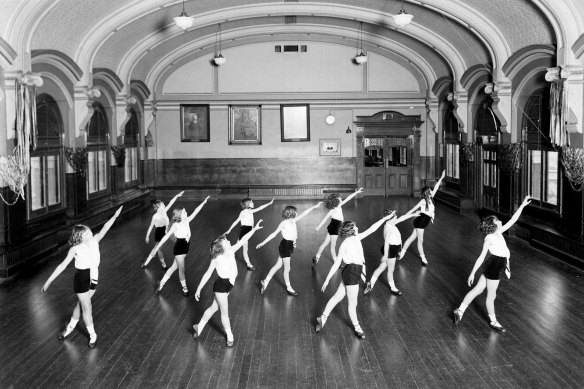
A 1930 “physical culture” class in the Flinders Street Station ballroom.Credit: Public Records Office of Victoria
The Institute provided educational and philosophical lectures, club rooms for numerous activities including poetry, fencing, debating and even cat lovers, alongside a gymnasium, billiards room, nursery, library and even a running track along the roof, popular with famous footballers of the day.
And, of course, the lavish ballroom, which hosted weekly dances, classes and ballroom competitions, was for a time one of the city’s most popular dance halls. But the last dance was called in 1983, and the ballroom, along with most of the other spaces, was closed in 1985.
The station has around 100 rooms over three levels, off a corridor running the length of platform one – but it’s the ballroom that holds the allure. Its imposing ceiling was restored in 2019, and debate about how to repurpose it has been part of the public conversation for decades.
We’ve seen photos, a lucky few have won “golden ticket” style ballots during the occasional Open House tour, and people talk of rock gigs held there in the 1990s, though nobody seems to know anybody who actually went. (There definitely was a piano recital held there in 2012, but without an audience.)
While the ballroom houses the “finale” of Piccinini’s exhibition, the first thing visitors see is a giant diorama, the kind once popular in natural history museums, which explores our relationship with culture and nature.
“This is the first time you think, oh OK, I’m walking into this historic place and it’s already quite magical,” Piccinini says. “It’s introducing the idea of the salient themes around how we relate to and understand nature.”
In another room a film tells the story of a relationship between a young woman and a creature. “The creature adopts her and she connects with it, and then realises that the best thing for the creature is to let it go,” she says. “That’s often what love is, it’s the dynamic of the maternal relationship – you love your children, but you have to let them go, and trust them; you have to relinquish control.”
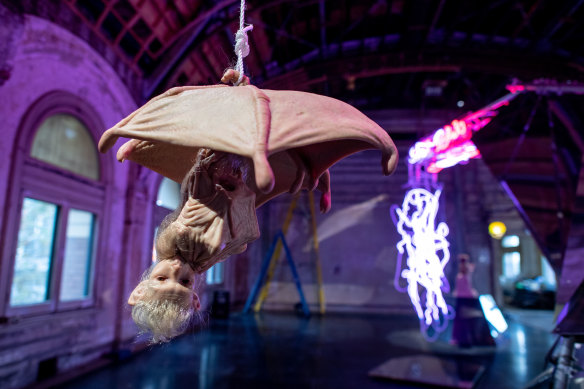
The Flinders Street ballroom and 10 other rooms have been transformed for <>A Miracle Constantly Repeated.Credit: Eddie Jim
It’s a reflection, she says, of the conversation we should be having about nature: “When we talk about climate change, we say ‘we must get the situation under control’, but it’s not about control. It’s actually the opposite.”
There are several of her signature chimera sculptures; new pieces, and others not seen in Melbourne before. One new work focuses on a paternal relationship (most of the work draws on the maternal), a human man and a chimera which is part human and part plant, a sloth-like creature whose arms extend into bulb-like endings instead of hands. It’s unnerving at first glance, but the intimacy of the sculpture is what captivates; it is, like much of the exhibition, about connection.
“This is about how we might understand a plant and the relationship we have to our responsibility for other creatures, like plants,” Piccinini says. A Miracle Constantly Repeating is rooted in the concept of “care”, she says, particularly around the environment.
Some works were created pre-COVID (the earliest is from 2018) but most are new, and their messages have more urgency now. “All of these other things we might quibble about will mean nothing if we don’t have an environment,” she says, adding that our relationship extends to more than just the human species.
Inter-species connection has always underpinned Piccinini’s work, and as the climate issue has become acute, her practice has evolved.
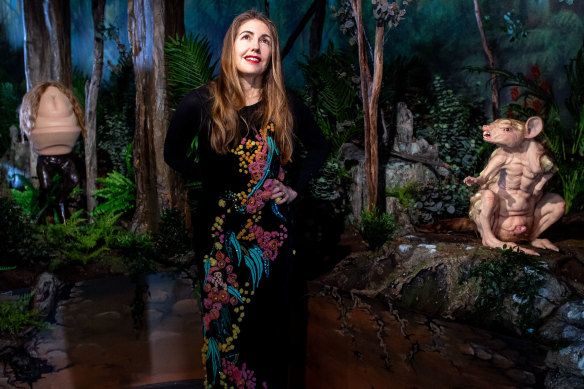
Patricia Piccinini in the diorama room at Flinders Street Station.Credit: Eddie Jim
“When I started 25 years ago, I was interested in how medicine changes how we understand the body, and then how that affects our responsibility to non-human animals that we take from. Now, it’s much broader and about how we can build a more workable definition of our relationship with nature.”
A sculpture of a young girl and a dolphin-human chimera in embrace echoes humanity’s relationship with nature. “We think ‘mother nature’ is always going to be there for us, we can do anything to her and she’ll always love us, but in some ways, like mothers, we’ve been able to … not care about them, take them for granted. They’re meant to look after us, we don’t have to look after them.”
Another new piece features a pair of Tasmanian tiger chimeras, while a startling large-scale sculpture of a person in a yoga-like pose was inspired by the Peregrine falcons that nest in a Melbourne skyscraper each year. In Piccinini’s vision, the person becomes the skyscraper, with small mythical (very cute) creatures perched on their legs. These are not quite flesh, but rather “a new ecological environment, an amalgam between something natural and something artificial,” Piccinini says. “The creatures are being held up in a similar way that Atlas holds the world. This person has the strength to be able to carry this new idea.”
The sculpture encapsulates Piccinini’s overarching theme of “speculative optimism” and is the last work before visitors reach the ballroom, where a huge, mirrored tree-like sculpture is surrounded by mushroom-like sculptures made of coloured glass.
”In the other rooms there’s a lot of ... thinking, but I wanted the ballroom to be one where people are just being,” she says. “I wanted some spectacle in there.”
She appreciates, too, that some may come for the building itself. “Some people aren’t interested in the sorts of things I am, but if they come to see the building, and then see my work, they might find it interesting, it might be something they hadn’t imagined it might be,” she says.
And she’s not offering up any answers here; just questions. “Careful questions put in a way that I hope invite a deep response.”
A Miracle Constantly Repeated is at Flinders Street Station from May 26. rising.melbourne